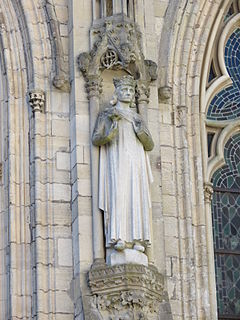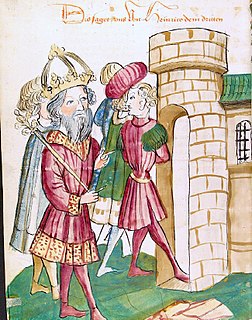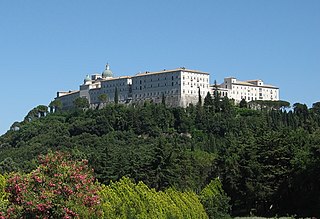Sources
- Rodulfus Glaber. Opera, ed. J. France. Oxford, 1989.
- Chalandon, Ferdinand. Histoire de la domination normande en Italie et en Sicile. Paris, 1907.
Rudolph Drengot [1] was one of the Drengot family of Norman adventureres who came to Southern Italy with his brothers, Gilbert, Asclettin, Osmond, and Ranulf.
The Drengots arrived in Italy in 1017 to support Melus of Bari in his rebellion against the Catapanate. According to some sources, they stopped in Rome on the way and Rudolph had an audience with Pope Benedict VIII. [2] Whatever the case, they aided Melus until their defeat at the Battle of Cannae (1018).
After this, Melus went north to Bamberg to meet the Emperor Henry II. Rudolph accompanied him. It is certain that Rudolph had an opportunity to then meet with the pope. He returned to the south on the emperor's expedition, after Melus' death, and was installed at Comino under one of Melus' nephews, a count. Rudolph then led some Normans back to Normandy.

Year 1058 (MLVIII) was a common year starting on Thursday of the Julian calendar.

Year 1018 (MXVIII) was a common year starting on Wednesday of the Julian calendar.

Year 985 (CMLXXXV) was a common year starting on Thursday of the Julian calendar.

The Battle of Civitate was fought on 18 June 1053 in southern Italy, between the Normans, led by the Count of Apulia Humphrey of Hauteville, and a Swabian-Italian-Lombard army, organised by Pope Leo IX and led on the battlefield by Gerard, Duke of Lorraine, and Rudolf, Prince of Benevento. The Norman victory over the allied papal army marked the climax of a conflict between the Norman mercenaries who came to southern Italy in the eleventh century, the de Hauteville family, and the local Lombard princes. By 1059 the Normans would create an alliance with the papacy, which included a formal recognition by Pope Nicholas II of the Norman conquest in south Italy, investing Robert Guiscard as Duke of Apulia and Calabria, and Count of Sicily.

Drogo of Hauteville was the second Count of Apulia and Calabria (1046–51) in southern Italy. Initially he was only the leader of those Normans in the service of Prince Guaimar IV of Salerno, but after 1047 he was a territorial prince owing fealty directly to the Emperor.
Humphrey of Hauteville, surnamed Abagelard, was the Count of Apulia and Calabria from 1051 to his death.

Guaimar IV was Prince of Salerno (1027–1052), Duke of Amalfi (1039–1052), Duke of Gaeta (1040–1041), and Prince of Capua (1038–1047) in Southern Italy over the period from 1027 to 1052. He was an important figure in the final phase of Byzantine authority in the Mezzogiorno and the commencement of Norman power. He was, according to Amatus of Montecassino, "more courageous than his father, more generous and more courteous; indeed he possessed all the qualities a layman should have—except that he took an excessive delight in women."
Rainulf Drengot was a Norman adventurer and mercenary in southern Italy. In 1030 he became the first count of Aversa. He was a member of the Drengot family.

Pandulf IV was the Prince of Capua on three separate occasions.
Melus was a Lombard nobleman from the Apulian town of Bari, whose ambition to carve for himself an autonomous territory from the Byzantine catapanate of Italy in the early eleventh century inadvertently sparked the Norman presence in Southern Italy.

Basil Boioannes, called Bugiano in Italian, was the Byzantine catapan of Italy and one of the greatest Byzantine generals of his time. His accomplishments enabled the Empire to reestablish itself as a major force in southern Italy after centuries of decline. Yet, the Norman adventurers introduced into the power structure of the Mezzogiorno would be the eventual beneficiaries.
Guaimar III was the Lombard prince of Salerno from around 994 to his death. Under his reign, Salerno entered an era of great splendour. Opulenta Salernum was the inscription on his coins. He made Amalfi, Gaeta and Sorrento his vassals and annexed much of Byzantine Apulia and Calabria.

Amatus of Montecassino, was a Benedictine monk of the Abbey of Montecassino who is best known for his historical chronicles of his era. His History of the Normans, is one of three principle primary sources for the Norman Conquest of southern Italy--the other two being the histories of William of Apulia and Geoffrey Malaterra. Amatus describes the Normans from the perspective of his abbey, one of the most important religious and cultural centers in Italy at the time. His history is the earliest extant account of the Norman sieges of Bari and Salerno, their conquest of Sicily, and the careers of both Robert Guiscard and Richard Drengot, as well as the Gregorian Reforms seen from the papal point of view.
Richard Drengot was the count of Aversa (1049–1078), prince of Capua and duke of Gaeta (1064–1078).
Gilbert Buatère was one of the first Norman adventurers in the Mezzogiorno. He was the eldest son of a petty, but rich, lord of Carreaux, near Avesnes-en-Bray in the region of Rouen. Carreaux gives his family, the Drengot, the alternate name of de Quarrel.
The Drengots were a Norman family of mercenaries, one of the first to head to the Mezzogiorno of Italy to fight in the service of the Lombards. They became the most prominent family after the Hautevilles.
The Principality of Capua was a Lombard state centred on Capua in Southern Italy, usually de facto independent, but under the varying suzerainty of Holy Roman and Eastern Roman Empires. It was originally a gastaldate, then a county, within the principality of Salerno.

The Italo-Normans, or Siculo-Normans (Siculo-Normanni) when referring to Sicily and Southern Italy, are the Italian-born descendants of the first Norman conquerors to travel to southern Italy in the first half of the eleventh century. While maintaining much of their distinctly Norman piety and customs of war, they were shaped by the diversity of southern Italy, by the cultures and customs of the Greeks, Lombards, and Arabs in Sicily.

The Norman conquest of southern Italy lasted from 999 to 1139, involving many battles and independent conquerors.

The County of Apulia and Calabria, later the Duchy of Apulia and Calabria, was a Norman state founded by William of Hauteville in 1042 in the territories of Gargano, Capitanata, Apulia, Vulture, and most of Campania. It became a duchy when Robert Guiscard was raised to the rank of duke by Pope Nicholas II in 1059.